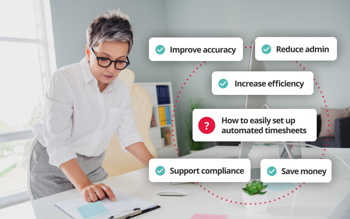
As the modern workplace continues to evolve, so do the management requirements for HR departments and businesses as a whole. Keeping on top of these responsibilities can be time consuming, and understanding where company time is being spent on a daily basis and how to optimise it is vital for continued growth and success.
Automated timesheets are a key development in HR software, allowing professionals to manage hours, track absences and monitor productivity all from a single interface. These tools can support HR and management teams looking to streamline processes, boost productivity, and foster business growth.
In this article, we’re going to look at what timesheet automation is, the benefits of implementing it in your HR processes, and the steps needed to set up an automated timesheet system for your organisation.
What are automated timesheets?
Automated timesheets are a type of electronic timesheet that uses software to automatically track and record employee work hours. They can be completed in several different ways, including manually inputting the hours worked, or through integration with payroll software or a time and attendance system.
Benefits of automated timesheets
The main benefit of automated timesheets is that they are much more efficient to complete, saving you time every pay period. It’s another example of the wide variety of time-saving HR software that can help small and growing businesses to thrive. Timesheet automation offers many different advantages when compared to manual or paper-based timesheets, including:
- Reduces admin: Timesheet automation cuts the need for manual data entry and calculations, freeing up valuable HR resources to focus on more strategic tasks.
- Improves accuracy: Automated timesheets reduce the risk of human error, ensuring that the hours recorded are consistently precise and reliable.
- Increases efficiency: By streamlining the time-tracking process, automation allows HR teams to do more in less time, boosting overall productivity.
- Supports compliance: Automated timesheet software includes built-in compliance functions to ensure that all employment laws and tax reporting requirements are adhered to.
- Saves money: Timesheet automation reduces administrative costs associated with manual time tracking and decreases the likelihood of payroll calculation errors.
How to set up automated timesheets
Learning how to do timesheets using an automated system is easy. Once you’ve set up your automated timesheet software, the process is much simpler and less time consuming than manual timesheet preparation. We’ve put together a step-to-step guide showing you how to set up automated timesheets below.
Step 1: Choose a timesheet automation software
If you’ve already invested in HR software, you’ll know that there are many different considerations to bear in mind when choosing the right HR solution . Deciding between the various timesheet automation solutions on the market follows the same process, with the most important consideration being the specific requirements of your business.
Other key things to think about include your budget, and any integration requirements that will allow you to use the automated timesheet software with your existing software and hardware. It’s also worth bearing in mind that, as your business grows, the workforce size and structure may also change. It’s therefore important to consider flexibility and scalability when comparing automated timesheet solutions.
Step 2: Configure the software
Once you’ve chosen your timesheet automation software, you’ll need to configure it for use with your business. Your HR manager will need to input a variety of essential information, from defining pay rates and the hours that employees are expected to work, to setting up projects and tasks to be tracked.
This step can be a little time consuming, but you’ll only need to do it once. As this information is used to calculate hours worked and amount of pay earned, it’s important to enter it carefully and check it for errors before you start using the software.
Step 3: Train employees on how to use the software
Make sure that your employees understand both how to use the timesheet automation software and why time tracking is essential for the business. Timesheet training isn’t mandatory, but it’s highly recommended to ensure that adoption of the new process goes smoothly from day one.
HR software providers often include training within their packages, which could vary from free articles and explainer videos to paid in-person sessions with your whole team. At PeopleHR, we offer a comprehensive HR software implementation process, including sessions with our expert training team.
Step 4: Monitor the system and make adjustments as needed
Particularly after first setting it up, it’s important to make sure that you monitor the system and check that it’s providing value. This may involve manually reviewing timesheets for accuracy in the first few weeks and months, adjusting the system’s configurations, and continuing training and education for all team members using the software.
This is the time to drill down into the real-world suitability of the automation solution for your business. You might find certain aspects of the timesheet process that are still taking up a lot of time, and that you would benefit from a more comprehensive system.
Many providers offer a free trial or software demo, giving you time to use the system for a period of time before committing to the final purchase. When investing in any piece of HR software to support your business, it’s well worth taking your time to compare different solutions, read customer reviews, and gauge the level of support and aftercare each one offers.
The past & future of automated timesheets
While punch-in clocks were once commonplace for tracking employee hours, they have been all but completely replaced by digital solutions. However, many businesses are still using crude forms of digital timesheet tracking such as manually entering hours on Excel spreadsheets. As well as being outdated, these methods are inefficient and often prone to human error.
As businesses adapt to modern ways of working, cloud-based software as a service solution have become much more commonplace, enabling more efficient processing and streamlined
collaboration between systems and departments. For automated timesheets in particular, employees can effortlessly enter their hours, and HR managers can track and process multiple timesheets instantly with the click of a mouse.
PeopleHR’s Timesheet Software is part of our integrated HR system allowing businesses to track hours, monitor employee attendance and manage timesheet reporting, all within a single interface. This sits alongside a complete suite of HR tools, along with expert support from the PeopleHR team. To see how timesheet automation can support your business, take advantage of our free trial today.
